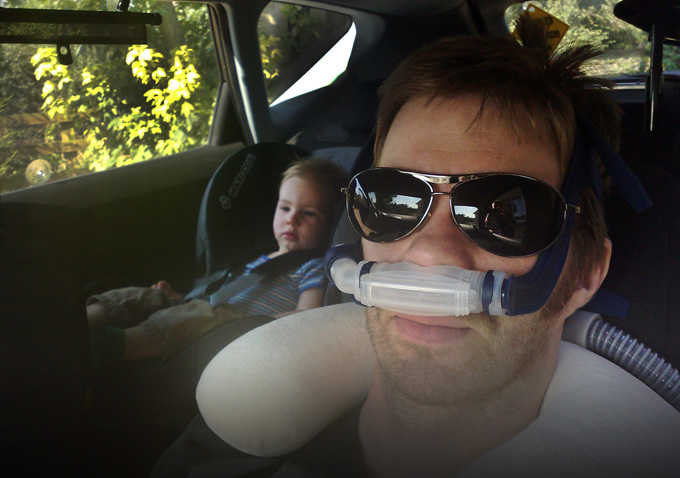 Actor Josh Gad recently called the Ashton Kutcher-starring Steve Jobs biopic “inspirational,” and why wouldn’t he? There is no doubt Steve Jobs the man continues to inspire, but that word—“inspirational”—is thrown around by actors, filmmakers, and even critics with reckless abandon. (My favorite came from a review of “Kick-Ass 2” that seriously stated: “[A] a sequel … that is both emotionally engaging and ambitiously inspirational.”) Calling “Jobs”—and “Argo,” “The King’s Speech,” and most other pleasant bits of Oscar bait, for that matter—“inspirational” is an insult to “I Am Breathing,” a stunning, profoundly moving Scottish documentary by filmmakers Emma Davie and Morag McKinnon.
Actor Josh Gad recently called the Ashton Kutcher-starring Steve Jobs biopic “inspirational,” and why wouldn’t he? There is no doubt Steve Jobs the man continues to inspire, but that word—“inspirational”—is thrown around by actors, filmmakers, and even critics with reckless abandon. (My favorite came from a review of “Kick-Ass 2” that seriously stated: “[A] a sequel … that is both emotionally engaging and ambitiously inspirational.”) Calling “Jobs”—and “Argo,” “The King’s Speech,” and most other pleasant bits of Oscar bait, for that matter—“inspirational” is an insult to “I Am Breathing,” a stunning, profoundly moving Scottish documentary by filmmakers Emma Davie and Morag McKinnon.
It is the story of Neil Platt, a 34-year-old father in the U.K. diagnosed with Motor Neuron Disease (M.N.D.), also known as Amyotrophic Lateral Sclerosis (A.L.S.) or Lou Gehrig’s Disease. It is no spoiler to say that we are viewing the last years of Neil’s life; his illness is terminal, and essentially, “I Am Breathing” documents his preparations for saying goodbye to his wife, Louise, and adorable infant son, Oscar. During the course of the 73-minute film, we learn about Neil’s past as an architect, discover that he inherited the disease from his late father, and watch as he writes a blog about his life called “Plattitude” (iambreathing.com/plattitude), puts together a letter and “memory box” for Oscar, and gradually loses his battle with M.N.D.
The filmmakers take the time to show the ordinary, mundane difficulties of everyday life, like his son Oscar’s avoidance of his baby food (Neil’s response to the taste of the “organic, sugar-free” food: “Blimey!”). His mother visits, and looks through an old photo album with glee at images of Christmases and Halloweens past. Neil works on his own funeral arrangements, and describes his attempt at cancelling his phone contract: “‘Can I ask you why, sir?’ ‘Because I’m dying.’” We listen as Neil crafts his letter to Oscar, explaining how he and Louise met, and “one thing led to another,” followed by “our first house … and then came the icing on the cake: you.” Life goes on, then, for Neil, Louise, and Oscar; as Neil puts it, “It’s amazing how adaptable we are, when we need to be.”

It is, at times, an almost overwhelmingly difficult viewing experience. Consider that this is a disease in which, Neil says, “your senses are not dulled at all—only the motor stuff. So you feel everything.” Lines like this make it nearly impossible not to be moved, but like “Amour,” a film that seemed even more dramatic to audience members who have watched loved ones in the grips of dementia, parents of small children are liable to find “I Am Breathing” an even more emotional experience than other viewers might. As the parent of a 3-year-old boy, I found it overwhelmingly hard to watch Oscar give his father a kiss, or see video of Oscar’s first birthday party. (Neil was already starting to feel the effects of the disease by this point: “At Oscar’s first birthday party, I was struggling to breathe,” he writes on his blog.)
“I Am Breathing,” however, is also packed with humor, much of it thanks to the “cheeky” Neil’s acerbic outlook on life. Yet even during lighter moments, the disease remains first and foremost on the minds of his family, and the viewer. The attitude of Louise is especially—here’s that word—inspirational. Hers might be the trickiest position of all. “How do I keep going? It’s because I’m [so] proud of him,” she says. Neil understands the toughness of his wife’s position better than anyone. “I’m not sure if anyone other than me can comprehend the physical strain, the emotional strength, and the sheer power of character my wife has,” he writes. As the film progresses, the humor lessens, and the effects of the disease become increasingly pronounced. The last twenty minutes, especially, are as difficult to watch as any moments onscreen this year.

Perhaps the only unnecessary element of “I Am Breathing” is the soundtrack. The background music is mostly unobtrusive, but certainly not needed. It seems to cheapen things, a bit—it feels Hollywood, and the rest of the film is so refreshingly anti-Hollywood that the effect is more negative than it should be. The style of the film is almost no style at all—handheld, fly-on-the-wall photography with many sequences that almost look as if they could have been shot by a family member. This aesthetic does not call attention to itself … unlike the music. Still, that is one small misstep for Davie and McKinnon.
What is most noteworthy about “I Am Breathing” is what it is not: horrendously depressing. Sure, it is incredibly sad, especially every scene with young Oscar. But “I Am Breathing” is not a documentary intended to induce sobbing. It is, instead, a film about dying that is stunningly alive, wildly optimistic, and always insightful and entertaining. You want to throw around that word, “inspirational”? Use it to describe Neil Platt, and “I Am Breathing.” [A-]

